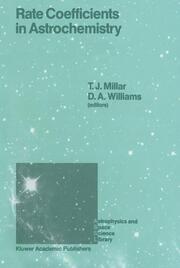Detailansicht
Rate Coefficients in Astrochemistry
Astrophysics and Space Science Library, Volume 146, Astrophysics and Space Science Library 146
ISBN/EAN: 9789027727527
Umbreit-Nr.: 1610039
Sprache:
Englisch
Umfang: xiv, 364 S.
Format in cm:
Einband:
gebundenes Buch
Erschienen am 31.07.1988
- Zusatztext
- ''An atteJDpt has been made to cOll1PlJte the numbers of certain JI10lecules in interstellar space,. A search for the bands of CH, O/{, DR, en and C2 would appear to be proIDising" P Swings and L Rosenfeld Astrophysical Journal 86,483(1937) This may have been the first attempt at modelling interstellar chemistry. As with models today, the methods used lacked reliability, but the speculation was impressive! Mark Twain might well have said of this infant subject "One gets such wholesale returns of conjecture out of such a trifling investment of fact". The detection of unidentified lines around the period that Swings and Rosenfeld were writing provoked much interest, but even the most optimistic speculator could hardly have imagined developments which would occur during the next 50 years. By 1987 about 70 varieties of molecule had been identified in the interstellar and circumstellar regions, They range in complexity from simple diatomics such as H2 and CO to such species as ethanol C2HeDH, acetone (CHs)2CO, and the largest interstellar molecule detected so far, cyano-penta acetylene HC11N, The study of these molecules in astronomy has developed enormously, especially over the last 20 years, and is now codified in the new subject of astrochemistry, That such a variety of chemical species should exist in tenuous regions of the Galaxy is fascinating.
- Kurztext
- Proceedings of a Conference held at UMIST, Manchester, U.K., September 21-24, 1987
- Autorenportrait
- InhaltsangabeTheory of Reactive Collisions at Low Temperatures.- Radiative Association.- Dissociative Recombination: Polyatomic Positive Ion Reactions with Electrons and Negative Ions.- Photodissociation and Photoionisation Processes.- Radiative Pumping and Collisional Excitation of Molecules in Diffuse Interstellar Clouds.- Charge Transfer in Astrophysical Plasmas.- Experimental Measurements of the Rate Constants for Neutral-Neutral Reactions.- Polycarbon and Hydrocarbon Ions and Molecules in Space.- Studies of Ion-Molecule Reactions at T < 80 K.- Drift Tube Studies of Ion-Neutral Reactions and their Relevance to Interstellar Chemistry.- Laboratory Studies of Dissociative Recombination and Mutual Neutralisation and their Relevance to Interstellar Chemistry.- Chemical Pathways from Atomic Silicon Ions to Silicon Carbides and Oxides.- Chemical Pathways for Deuterium Fractionation in Interstellar Molecules.- Diffuse Cloud Chemistry.- Dense Interstellar Cloud Chemistry.- Hot Molecular Cores: A Case for Accretion.- Chemistry in Shocked Interstellar Gas.- Dynamical Models of the Chemistry in Interstellar Clouds.- Chemistry in Expanding Circumstellar Envelopes.- Condensation calculations in Circumstellar Shells for Different C/O Ratios.- Chemistry in Primary T Tauri Winds.- The Photochemistry of Planetary Atmospheres.- The UMIST Rate File for Astrochemistry.- Name Index.
